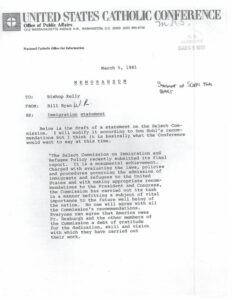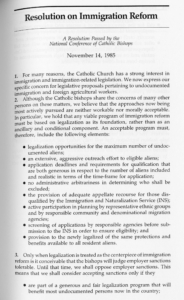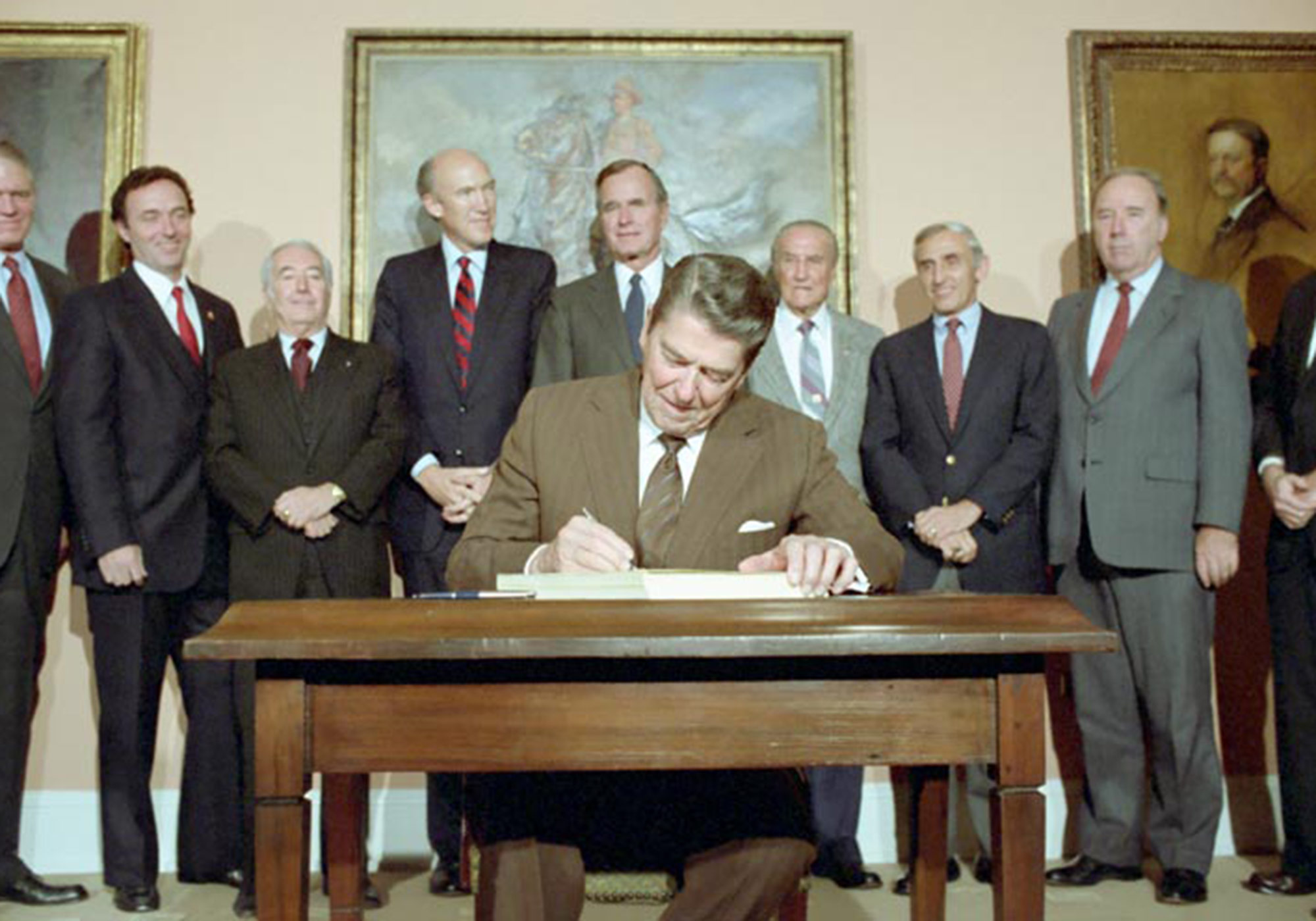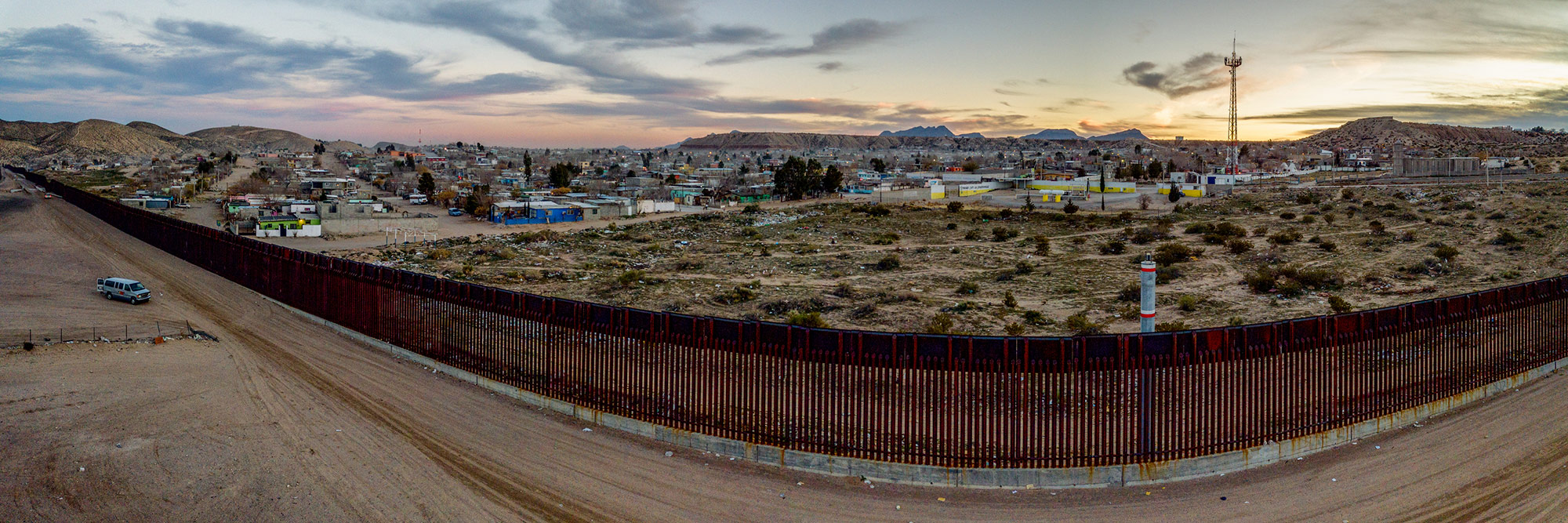Lesson 2
The Immigration Reform and Control Act and its Aftermath
A New Day?
For a decade after Msgr. Higgins provided testimony on pending immigration legislation, Congress continued to muddle through on the issue, offering new legislative iterations, but never successfully securing any final agreement. In 1978, the Select Committee on Immigration and Refugee Policy (SCIRP) was established (Public Law 95-412), with the purpose of studying and evaluating existing laws, policies, and processes that guide the admission of immigrants and refugees into the country and providing recommendations to Congress and the President. It was hoped that the existence of such a commission might expedite reform efforts, or at least buy some time until such an opportunity arose.
The governor of Florida, Reuben Askew, was originally appointed as chairman of the Commission, but was soon replaced by Rev. Theodore Hesburgh, President of Notre Dame, in October 1979. In the Commission’s early stages, members and staff visited immigrant and ethnic communities in a dozen states and invited representatives from various organizations to give testimony at two dozen, publicly attended consultations in Washington, D.C.
The Commission’s final report, issued March 1, 1981, highlighted the importance of clearly defining the specific goals that U.S. immigration policy is trying to achieve, and the processes and institutions that should be established for the efficient adjudication of these goals. To that end, the Commission provided recommendations related to discrete legislative and administrative proposals, including the provision of an amnesty, an employer sanctions program, and increased border enforcement. Too wide ranging to discuss in detail here, the report noted that taken in their totality these recommendations could be summed up “quite simply,” namely:
“closing the back door to undocumented/illegal immigration, [and] opening the front door a little more to accommodate legal migration in the interests of the country, defining our immigration goals clearly and providing a structure to implement them effectively, and setting forth procedures which will lead to fair and efficient adjudication and administration of U.S. Immigration laws.”
The United States Catholic Conference acknowledged the importance of the Commission and the comprehensiveness of its final report. Regarding specific policy proposals recommended by it, the USCC supported the Commission’s affirmation of the importance of family unity, the recommendation to legalize current undocumented migrants, and support for an increase in annual refugee admissions. USCC leadership expressed concern with respect to some of its enforcement proposals, particularly employer sanctions. Without having a mechanism to identify who was legally eligible for employment and who is not eligible, employer sanctions risked raising the “specter of discrimination.”

Memo from Bill Ryan, USCC Office of Public Affairs, to Bishop Thomas Kelly, General Secretary of NCCB/USCC, March 5, 1981. Available at the American Catholic History Archives/The Catholic University of America.
This “specter” became a prominent point of concern of Catholic leadership as it pertained to employer sanction provisions proposed in future legislation. Several months after the release of SCIRP’s final report Bishop Thomas Kelly, General Secretary of the NCCB/USCC, issued a memo to the United States Catholic Conference’s Executive Committee expressing concern about any sanctions program. Here he noted the likelihood that “Latinos would be unduly targeted by employer sanctions without proper protections; all employees should be required to prove employment eligibility, not merely those who appeared to be ‘foreign born,” and further suggested that some form of employment verification card be made available to everyone available to work.
Although troubling, the inclusion of an employer sanctions provision in an immigration reform bill was not deemed a so-called “poison pill” by Church leadership. Rather it was important that any legislation not focus exclusively on the implementation of new enforcement mechanisms, and that they be offset by protections ensuring that specific populations would not be targets of any sort of tacit or explicit discrimination. Legislation would also have to include a generous legalization process.
This precondition was reaffirmed on the eve of the Immigration Reform and Control Act’s passage. In their 1985 “Resolution on Immigration Reform”, the USCC stated that any immigration reform legislation “must be based on legalization as its foundation, rather than an ancillary and conditional component,” and that “only when legalization is treated as the centerpiece of immigration reform is it conceivable that the bishops will judge employer sanctions tolerable.”
- Additionally, the statement reiterated their conviction that any employer sanctions component would have to be accompanied by clearly defined and enforceable anti-discrimination legislation, the development of a secure and uniform employment identification system, and assurances that enforcement efforts would not focus disproportionately on employers who hire predominately minority populations.
A New Day? Passage of the Immigration Reform and Control Act
On November 6, 1986, President Reagan signed into law the Immigration Reform and Control Act (IRCA). Key provisions included in the final legislation reflected proposals offered at different points in the previous decade. First, to eliminate the jobs magnet an employer sanctions program was implemented, which would punish employers who hired unauthorized migrants. Second, border security measures were expanded, and resources appropriated to help border patrol respond to illicit border crossings. Third, a conditional legalization process was offered to individuals living in the United States in unauthorized status.
The passage of IRCA in October 1986 signified an obvious breakthrough to the gridlock that had ensured an unworkable status quo for more than a decade. The legislation enabled millions of individuals living in the country illegally to adjust their status and move toward citizenship but required that they had to reside in the U.S. prior to January 1, 1982. This cut-off date likely left thousands of people unable to secure an adjustment of status due to their arrival at some point during the four subsequent years. Nevertheless, alternative proposals offered qualifying dates as early as 1978, which would have disqualified many thousands more unauthorized migrants. Although employer sanctions were part of the bill, it did not contain a sunset provision to end the employer sanctions programs. The final legislation, however, did require the General Accounting Office to study the sanctions component after three years their discriminatory effects.
While IRCA focused much of its attention on solidifying enforcement efforts to prevent future irregular migration flows (e.g., employer sanctions), paired with a legalization program that would deal with unauthorized migrants living in the United States, the Immigration Act of 1990 turned its attention to managing pathways for legal immigration. In doing so, Congress “revised and substantially expanded the U.S. visa system, originating from the desire to ‘open the front door wider to skilled immigrants of a more diverse range of nationalities’.” (Donato, 2020, 7) Through this legislation a series of reforms were implemented, including the creation of a diversity visa lottery, temporary protected status for specific vulnerable populations, five new employment-based visas, and implemented adjustments to the family-based admissions program.
Although both IRCA and the Immigration Act of 1990 generally exemplified many pro-immigrant policies, within a matter of a few years a notable shift in temperament occurred – restrictionist sentiments became ascendant. This shift was partly due to the growing influence of immigration restrictionist organizations who stoked these sentiments in key receiving states, including Texas and Florida. Initially focused on the issue of illegal immigration, the goal of many of these organizations was on substantial revisions to legal pathways. (Tichenor, 275-277).
On the state level, the passage of state initiative Proposition 187 in California (1994) was a prominent example of the ascendancy of immigration restrictionist sentiment among the public. On the federal level, initiatives were implemented along the US-Mexico border to stop the influx of irregular migration. One of the more telling examples of these efforts at the time was Operation Blockade, initiated in 1993 by Border Patrol Chief Sylvester Reyes in the El Paso region, which had long been a popular crossing point for irregular migration. The purpose of the initiative was to significantly increase enforcement in the region, thus clamping down on illegal crossings. The implementation of this enforcement effort led to a substantial decline in the urban area surrounding El Paso and was deemed at the time a successful strategy to limit illicit border crossings. (Massey, 2003)
In response, Bishop Raymundo Peña of El Paso and Bishop Juan Sandoval of Juarez, Mexico issued a statement that was critical of the strategy and noted that, while the Church does not condone law breaking, laws must be structured in such a way that they respond to the realities on the ground. They contended that most of the people who crossed the border were day laborers trying to make money to support themselves and their families. This kind of cross border migration was not something novel but rooted in the social and economic life of those living along the border. The blockade disrupted longstanding migration patterns and in doing so undermined the well-being of border communities, both on the US and Mexico side.
In response, both bishops called for a moratorium on the blockade and to use that time as an opportunity to develop policies that would better respond to the complicated economic and social conditions along the border. His call went unheeded, as Operation Blockade was generally seen in Washington, DC as a successful mechanism to inhibit illicit border crossings and was subsequently expanded to other urban areas along the border.
The apparent success of the blockade strategy promoted around El Paso and San Diego focused Washington’s attention on the usefulness of border enforcement when dealing with immigration. Since that time, the United States has witnessed significant growth in funding aimed at border security. One study published by the National Immigration Council noted that in 1990, US Border Patrol annual budget was 263 million dollars. By 2021, it had increased to nearly 4.8 billion dollars, a nearly twenty-fold increase. In 1986 there were 3,693 Border Patrol agents. By 2001 that number had increased to 9,651, and as of January 2022, 19,536 were employed by Border Patrol.
As border enforcement efforts increased, unauthorized passage between the two countries became more difficult and dangerous. Migrant deaths in the border region increased, smuggling efforts became more expensive and more fraught with risk. As it became more difficult to move back and forth across the border safely migrants were less likely to return home, and many sought to bring family members to the U.S. side of the border. Rather than lowering the likelihood of unauthorized migration, increased enforcement had the paradoxical effect of keeping people in rather than out. (Massey and Fernandez-Kelly, 2007)
Alongside efforts to secure the border, legislation enacted in the 1990s, and particularly the Illegal Immigration Reform and Immigrant Responsibility Act and The Personal Responsibility and Work Opportunity Act of 1996 (aka, welfare reform) provided “get tough” measures on unauthorized migrants living in the United States. Various provisions tightened asylum processes, enhanced the federal government’s ability to guard national borders, and severely curtailed access to public benefits by noncitizens. Although legal immigration was not dramatically reduced during this period, an enforcement heavy emphasis on immigration policy had taken center stage in political debates in Washington, DC.



